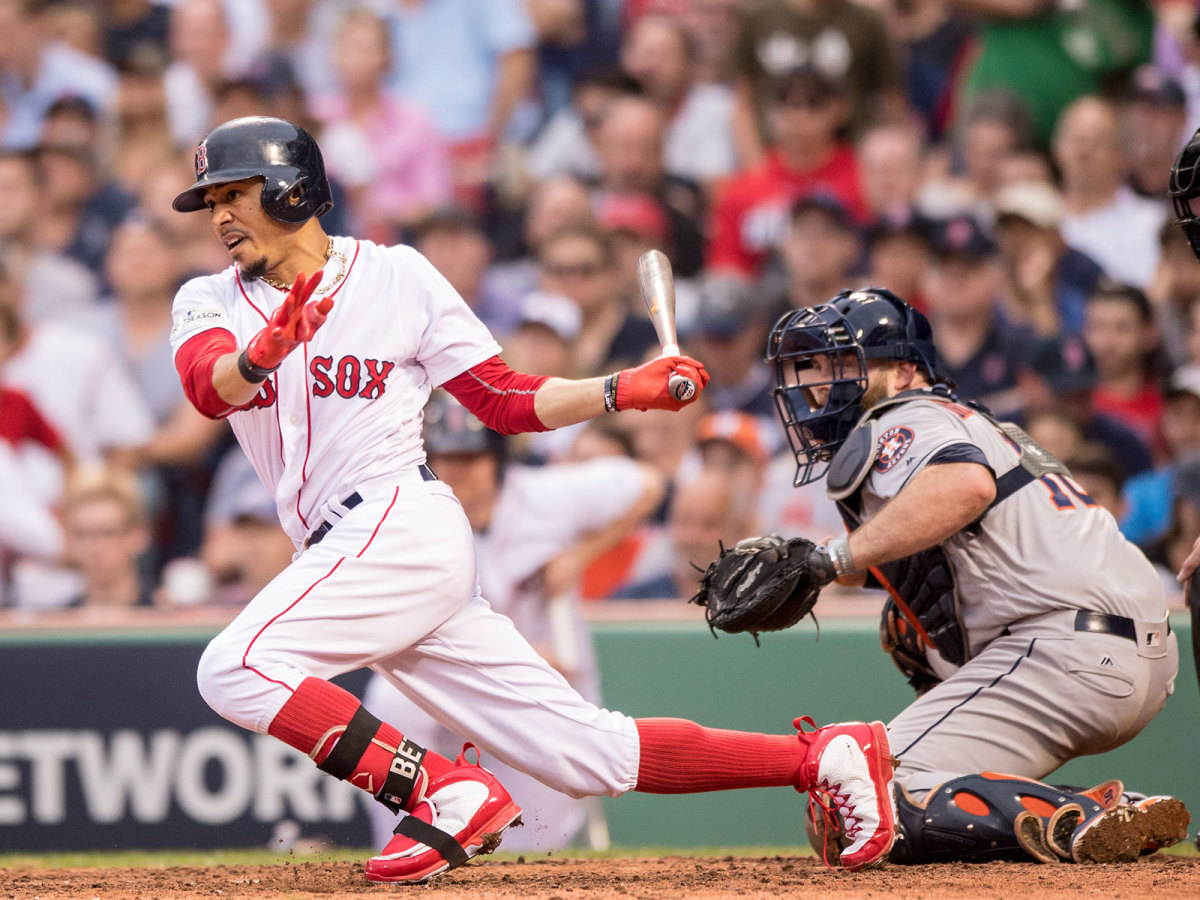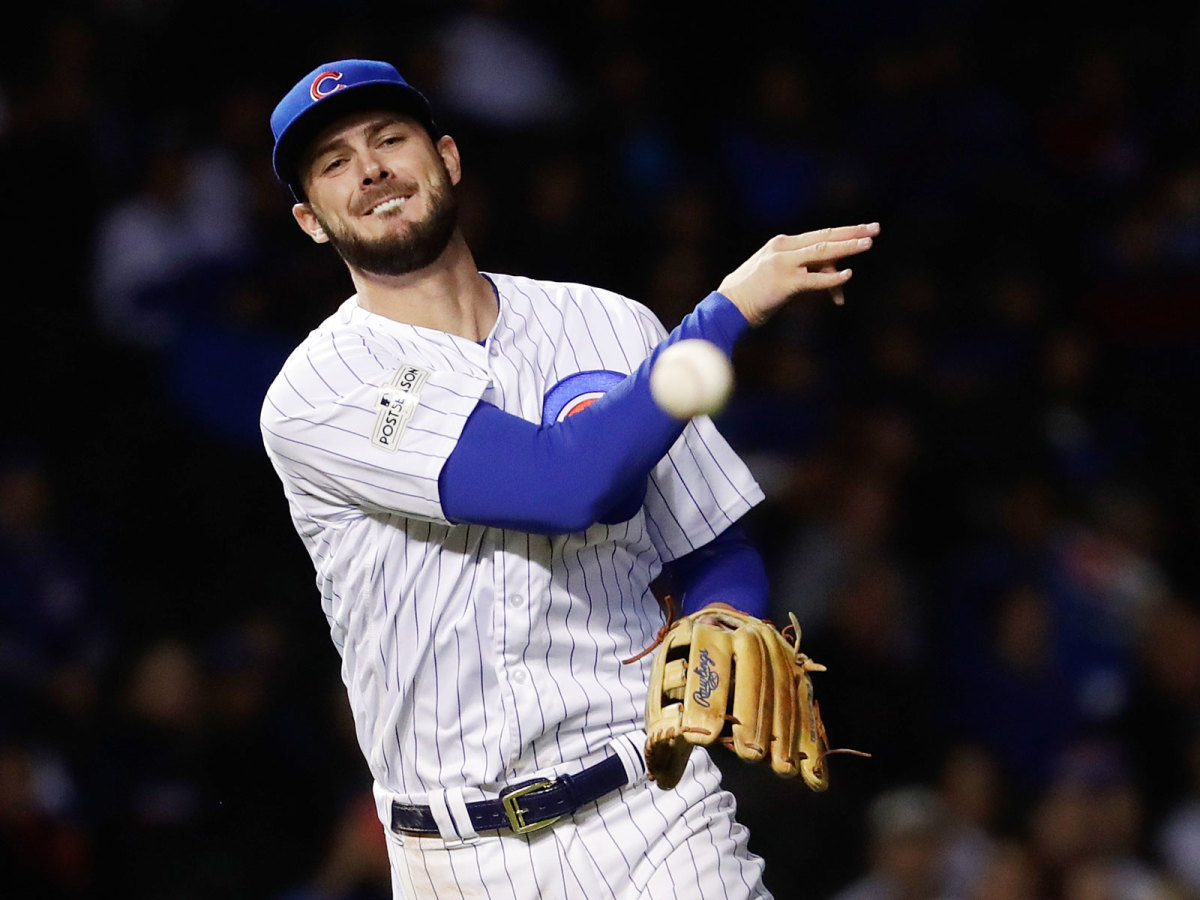SI's Top 100 MLB Players of 2018: The Top 10

SI's MLB writers are proud to present our Top 100 for the 2018 season. The exercise is intended to demonstrate the players most likely to have an impact on the 2018 season based on past performance (we created a weighted WAR average over the past three seasons), injury history and future predictors. And then we argued among ourselves, tinkered with the list and, over time, concluded our rankings.
The goal was to evaluate each player independently (as well as we could, at least). We know that stats can be skewed by a player's team (would Chris Taylor be ranked if he were playing in Tampa Bay? Would Steven Souza crack the list if he were a Yankee?), but we felt our weighting system was the best way to rank players along with one essential question: Which player would you rather have if you needed to compile a roster in 2018? The player that was universally agreed upon was the one who received the higher ranking. Salary was not considered, and 2018 rookies were not included. Many thanks to the essential online resources: Baseball Reference, Fangraphs and Brooks Baseball, among others, for their assistance in helping us create this list.
The rankings are inexact. They are controversial. They may exclude players that you think are essential. So let's get to the final round.
10. Paul Goldschmidt, Diamondbacks
Gabriel Baumgaertner: In June 2013, Paul Goldschmidt's teammates took to calling him "America's First Baseman." Over the years, Arizona fans have made t-shirts with the nickname, and last year the Diamondbacks tweeted "America's First Baseman" next to a photo of Goldschmidt to try and garner support for his MVP campaign. The problem with that nickname? It's hard to believe that many people—even serious baseball fans—would be able to identify Goldschmidt in a police lineup.
It's too bad, because the cornerstone first baseman is one of baseball's best all-around players.
After another spectacular season last year—.297/.404/.563 with 36 home runs and a Gold Glove—Goldschmidt finished third in NL MVP voting, the third time he's finished top-three in MVP voting. Goldschmidt has it all: Durability (he's played at least 155 games in four of the last five seasons), plate discipline (95 or more walks four of the last five seasons), defense (three Gold Gloves), speed (at least 18 stolen bases in each of the last three seasons) and, of course, power.
9. Carlos Correa, Astros
Jon Tayler: It’s easy to forget, the first time you look at them, how ludicrous Carlos Correa’s numbers are. A .315/.391/.550 line is insane enough for a player no matter the position; to do that as a shortstop is unheard of; to post that kind of production at 23 years of age is mind-boggling. And that’s only a taste of what Correa can do, as he was limited to 109 games by a hand injury but was absolutely mashing before and after.
It’s generally no good to anyone to throw historical comps onto players so young and so early in their career, but the truth is that Correa right now is as close as we’ve gotten to the halcyon days of Alex Rodriguez (at least, without the drugs) at shortstop. That may feel like blasphemy to some and too much too soon to others, but take a look again at the stats he produced, and then come and tell me that that kind of comparison is overblown. Houston lucked into a generational talent with Correa; so, for that matter, did all of baseball.
8. Nolan Arenado, Rockies
Gabriel Baumgaertner: The shadow of doubt hovers over Arenado because he plays in Colorado. That's unfortunate because his splits aren't nearly as disparate as they are for his teammate Charlie Blackmon. Sure, there is a huge gap in average (.336 at home, .283 on the road), but the power numbers (19 homers at home, 18 on the road) are close. Maybe he wouldn't be the offensive powerhouse for another club that he is for the Rockies, but he would still be the best defensive third baseman in the game. Arenado has already won five gold gloves and he's entering his age-27 season. Third base is the deepest position in baseball today, but none can quite do what Arenado can. Just take seven minutes to witness these highlights.
What may be most encouraging about Arenado is that his on-base percentage has increased each of the last two seasons and, in turn, his OPS+. Maybe his offensive numbers will be a tad inflated since he'll likely play most of his career in Colorado, but Arenado's peripherals show that he's still improving. He's the best defensive infielder in baseball, and he's one of the most feared hitter around. Those qualifications alone make him an easy choice to be in the top 10.
7. Clayton Kershaw, Dodgers
Jay Jaffe: On a per-batter or per-inning basis, Kershaw is the best starter in the game. Over the past three years, his 2.07 ERA, 2.28 FIP, 8.1 K/BB ratio and .535 OPS allowed are the majors' best by wide margins. However, back injuries have cost the three-time Cy Young winner about half a season over the past two years, and probably at least one piece of hardware; he threw 101 fewer innings than Max Scherzer from 2015–17, and there's just no hiding that.
Gabriel Baumgaertner: Kershaw has struggled with his durability the past two seasons. If he hadn't, there's a strong chance he'd have won five consecutive Cy Young awards. Like Mike Trout, Kershaw is only compared against himself. He owns virtually every statistical category over the last five years and should have been awarded the 2017 Cy Young Award (he was punished for missing all of four or five total starts). If there's one starter to take in the game today, it's Kershaw ... and by a fairly wide margin.

6. Mookie Betts, Red Sox
Jay Jaffe: How can you not love a player who answers to “Mookie,” let alone one who’s a 5’ 9” converted second baseman who has bowled multiple perfect games and excelled in two-strike situations? Betts didn't have his best year with the bat in 2017, but thanks to the combination of his power, speed and of-the-charts defense—+63 Defensive Runs Saved over the past two season thanks to all those extra-base hits taken away—he has become one of the game's elite players. In fact, via Baseball-Reference's version of WAR, only Trout has been more valuable over the past three years.
5. Joey Votto, Reds
Jack Dickey: What’s left to say about the magic of Joey Votto at bat? He’s first among active players in career on-base percentage, third in career batting average, and fifth in slugging. In the 2017 season—a season during which he turned 34 years old—he walked 134 times against only 83 strikeouts. He had a 1.032 OPS. No player swung at a lower percentage of pitches outside of the strike zone. Offensively, he is baseball’s closest thing to a wizard, capable of doing whatever he wants at the plate, no matter the limits the game would seem to impose naturally. He holds his own in the field, too. Age may slow him down someday, but no time soon. Will his teammates hold up their end of the bargain in 2018?
4. Max Scherzer, Nationals
Jay Jaffe: It's entirely possible that a fully healthy Clayton Kershaw would have won the NL Cy Young award in each of the past two seasons due to superior run prevention, but Scherzer wears the crown as the best pitcher in baseball right now because durability counts. Over the past three seasons, he's thrown more innings, struck out more hitters and accumulated a higher pitching WAR than anyone in the game, and risen to the level of his record-setting, seven-year, $210 million contract by pitching his way onto a Hall of Fame track thanks to those three Cy Youngs.
Beyond the numbers and the hardware, the heterochromic hurler is simply one of the game’s most entertaining players, a threat to throw a no-hitter on a good day or night. In 98 starts since joining the Nationals, he’s spun at least five hitless innings 11 times, and completed the job twice.

3. Kris Bryant, Cubs
Jon Tayler: Here is how good Kris Bryant is. Last season, he hit .295/.409/.537 in 665 plate appearances, homering 29 times, posting a 143 OPS+, and racking up 6.1 WAR. With the exception of a dip in homers and WAR, those numbers were almost bang on, if not better than, what he did in his MVP-winning 2016 campaign. And yet when it came time to hand out the National League hardware, Bryant finished a distant seventh in the MVP voting.
That isn’t to suggest that he deserved the trophy over Giancarlo Stanton; just to note that the bar is already so high for him that repeating a literal MVP season isn’t enough to sway the voters. But that doesn’t take away from what Bryant is, has done and should do as he ages further into his peak (incredibly, he’s still only 26 years old). The great debate over the best third baseman in baseball is fierce and full of competitors, from Bryant to Nolan Arenado to Josh Donaldson to (for the time being) Manny Machado. Consider this our vote for Bryant and his non-threatening, Bobby Sherman-style good looks. It’s hard to imagine someone doing better.
2. Jose Altuve, Astros
Gabriel Baumgaertner: Altuve's hitting stats are so good that they take a minute to process. He has compiled at least 200 hits in four consecutive seasons. He's hit at least 39 doubles in each of those four seasons. He's hit 24 home runs in back-to-back seasons. He led the big leagues in total WAR (8.3) and batting average (.346) on the league's best offense. He hit at least two home runs in each of his three postseason series. The best part about all of this? Altuve is right in the middle of his prime. He's entering his age-28 season, and has proved to be one of the most durable great players in the game (he's played at least 147 games every year since 2012).
At this point, it's just about watching Altuve as often as you can. He's one of the great natural hitters to grace the game in decades and an inspiration to any young player who thinks they're too undersized to make the big leagues.
1. Mike Trout, Angels
Jay Jaffe: Trout's combination of power, speed and defense make him the game's best player by a wide margin; his 26.7 WAR over the past three years is about five wins ahead of second-ranked Jose Altuve. The gap would be wide had the Millville Meteor not missed six weeks in 2017 due to a torn ligament in his left thumb, interrupting what was shaping up as his best offensive season, not to mention his run of five straight seasons leading the league in WAR. As it was, he still set career highs in on-base percentage (.442), slugging percentage (629) and OPS+ (187) while leading the league in each category. Remarkably the possibility exists that the now 26-year-old is getting better.
What’s more, Trout is clearly on a Hall of Fame track. Despite spending just six full seasons in the majors (plus a 40-game cup of coffee in 2011), his seven-year peak WAR ranks fifth all-time among centerfielders, trailing only Willie Mays, Ty Cobb, Mickey Mantle and Tris Speaker. By the end of this season, he’ll likely rank seventh in JAWS, behind that quartet plus Ken Griffey Jr. and Joe DiMaggio. And again, he’s just 26.
